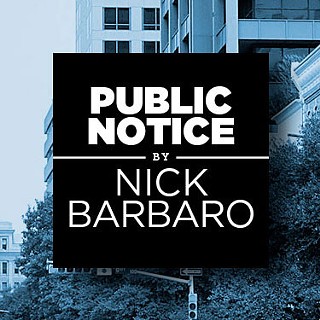Public Notice – Code X: The Final Chapter?
What to look for when the new LDC draft comes out tomorrow
By Nick Barbaro, Fri., Oct. 4, 2019
City staff is set to release the new draft of the proposed land development code rewrite this Friday (keep reloading www.austintexas.gov/ldc) and let the spin begin. FWIW, here are the first things I'm going to be looking for.
What Does It Mean for [Your Name Here]? I'll admit it: The first thing I'll do when the draft comes out is look at what it means for the Chronicle office: first at the map to see what our zoning is, and then at the code text to see what that means. Then I'll do the same for where I live, and the corridors near us. If you own property in the city, or lease, or have an interest in a business, you should do the same. (When I looked us up in the first draft of CodeNEXT, for instance, I found that office use was no longer allowed in our office building. That was fixed in later drafts, and I don't expect anything so dramatic this time around, but you never know.)
Housing Affordability: Does the code promote both the construction of new dedicated affordable units, and the preservation of existing "market affordable" units that are rapidly being torn down in older central neighborhoods? Those are two separate issues, but they're complementary, and both depend strictly on how much the drafters (and soon the Council) truly care about housing affordability. If we truly want affordable housing, then as many upzonings as possible will be tied to affordability density bonuses. If we truly want market affordability, then there will be incentives to keep such homes from being torn down and replaced with something larger and more expensive. On the flip side, every upzoning that's not tied to an affordability requirement is a lost opportunity, a case of settling for density over affordability.
"Complete Communities": Does the code promote "walkable, bikeable, and connected" neighborhood centers throughout the city? We have 10 Council districts, with roughly equal populations, and the stated goal is to create those walkable, connected centers in all of them. Thus far, most of the discussion has been on the mobility corridors, which cluster in the central city, but I'll be curious to see if there's a serious effort to "prioritize all types of homes for all kinds of people in all parts of town," as the Council direction put it.
Impervious Cover: This is something of a red line for many: If impervious cover is allowed to go up from 45% to 50-60% in corridor zones, as staff has hinted, they'll have to explain how that's sustainable in each of the city's watersheds, and each of the areas of localized flooding.
Parking: Council direction decreed that none be required within 1/4 mile of corridors, except where that would be "disruptive." It'll be interesting to see how staff interprets that.
Transition Areas: Are they zoned with some sensitivity, and some effort to be compatible with existing neighborhood plans? We know there are going to be considerable upzonings along corridors – which comprise large sections of most central city neighborhoods – but what will be telling is whether staff has been able to succeed in "establishing harmonious transitions between different types of land uses," as the Imagine Austin comprehensive plan put it. And the evidence will lie more in the code than in the mapping. It's one thing to say that in this whole area, six units are allowed per lot, instead of the current two, but the devil is in the details: What are the specifications for that six-unit building – setbacks, height, ground cover, utilities, garbage pickup, etc.? Those sorts of details are going to govern what actually gets built, and how it will function.
Ease of Use: Are the code structure and language readable, usable, and logically designed? The 1,388-page behemoth that was CodeNEXT was widely panned on this score, with nagging problems with terminology, illogical cross-references, and technical details that I don't pretend to understand, but were vexing to the architects and planners who worked on modeling and testing. So I'll have to wait for the reviews to judge this one, and those may not come in for a while, because ...
Bear in mind, there's still going to be a lot of work left to do before this is ready to become law. Staff has done yeoman work to get this far on Council's ambitious deadlines, and – well, we'll see tomorrow, but all indications are that there are still a lot of holes to fill, and placeholder regulations to be tweaked and shored up, and especially tested. Let's hope Council has the patience and political will to let that process run its course.
There’s a special called Council work session next Tuesday, then a series of info sessions and office hours begins Thursday; see the full schedule with this story online.
Upcoming Events
Tue., Oct. 8: City Council Special Called Work Session, City Hall, 10am-noon
Thu., Oct. 10: Dist. 9 Town Hall, City Hall, 7-9pm
Sat., Oct. 19: Open House & Office Hours, Conley-Guerrero Senior Activity Center, 808 Niles St., 10am-2pm
Mon., Oct. 21: Dist. 10 Town Hall, Highland Park Baptist Church, 5206 Balcones Dr., 7-9pm
Wed., Oct. 23: Open House & Office Hours, Austin Central Library, 6-9pm
Thu., Oct. 24: Dist. 7 Town Hall, Lamar Middle School, 6201 Wynona, 6-8pm
Studies, Plans, and Programs, for Mobility, Transit, and Transportation
The Greater Austin Chamber will host a summit on Improving Regional Mobility Together, Mon., Oct. 7, 2:30-6pm at the JW Marriott Austin, with Mayor Steve Adler, Texas Sen. Kirk Watson, CapMetro's Randy Clarke, with reps from the Capital Area Metropolitan Planning Organization (CAMPO), Bergstrom airport, TxDOT, Ford, and more. $75, $65 for Chamber members. See more info at www.austinchamber.com.
Meanwhile, CAMPO is hosting a series of open houses to share information on the Regional Transit Study and amendments to the 2019-2022 Transportation Improvement Program and the 2040 Regional Transportation Plan. Attend one of the meetings – Tue., Oct 8 in Luling, Wed., Oct. 9 in Kyle, Thu., Oct 10 in Elgin, Tue., Oct 15 in Georgetown, Wed., Oct. 16 in Marble Falls, Thu., Oct 17 in Bee Cave – or visit the online open house at www.campotexas.org/get-involved. The deadline for comments is Nov. 8 for the TIP and RTP amendments, and Nov. 22 for the Regional Transit Study.
Got something to say on the subject? Send a letter to the editor.









